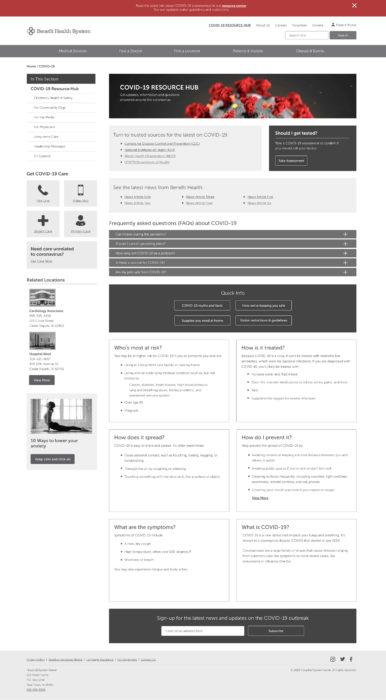1. Update Your Editorial Style Guide
COVID-19 has introduced a new lexicon to our communities. Make communicating about the new virus and an unprecedented public health situation easier by creating an addendum to your style guide and sharing it across your organization.
Editorial style guides help your team develop content that’s clear, accurate, consistent, and reflective of your brand. If your team already has a style guide, it likely includes guidance around voice and tone, grammar, punctuation, formatting, and tricky words.
Consider adding entries on:
- Acceptable ways to refer to the virus
- Any new program, facility, or location names related to COVID-19 care
- Definitions of terms that have become popular during the COVID-19 outbreak, such as “home quarantine” and “self-isolation,” and guidance on when to use them
- How to refer to your telemedicine services
- Preferred resources for COVID-19 information (for example, the Centers for Disease Control and Prevention)
- Words to avoid
Need help? Review The Associated Press Stylebook’s new entry on coronaviruses.
2. Create a Central Resource — or 2
Build a crisis resource hub. The hub makes it easy for people to access information, and it also makes managing content easier for your marketing and communications team.
Consider two hubs — one on your internet for external audiences and another on your intranet for internal audiences.
3. Streamline Your Workflow
In the early days of a crisis, adrenaline may keep your team fueled through a surge of urgent communications. But as the initial phase passes, the need for communication stays steady, so streamline your workflow as much possible.
For general COVID-19 information, link to reputable national resources, like the Centers for Disease Control and Prevention (CDC). You can even embed their public health media library content about the coronavirus on your own site. This lets you connect your website visitors with accurate, up-to-date information while saving you and your stakeholders time.
Focus your time, and the time of your stakeholders and subject matter experts (SMEs), on content that’s specific to your organization or community. When sending content for internal review, help your SMEs provide efficient, effective feedback by giving clear expectations around the purpose of the content you’re creating, their role, and the deadline for their input.
4. Create a Content Review Schedule
As news breaks, recommendations are updated, policies change, classes and events move online, and volunteer or donation needs evolve, your team is creating a lot of content.
Make sure your community is seeing — and acting on — the most current information by establishing a crisis content review process.
It may not be realistic to review every page of COVID-19-related content every day. So set a schedule to review higher-priority content often, and other content less frequently.
For example, you may set schedules to review:
- Pages that generate the most traffic
- Pages older than a time range chosen by your team
- Pages that contain the phrase “COVID-19” or “coronavirus”
- Pages that mention a specific policy, need, or class that’s just changed
Create a plan that fits your content needs and your team’s capacity.
Documentation & Tracking
Document your plan, and then use a spreadsheet to keep track of:
- Pages to review
- Person responsible for page review
- Review date
- SME or stakeholder for content (if needed)
- Changes made to published pages
Need Help?
Need help managing your COVID-19 content — or the hundreds of other web pages you’re responsible for? Geonetric’s healthcare writers and content strategists can help. Let us know how we can jump in as an extension of your team so you can meet your short-term and long-term marketing and communications goals.









